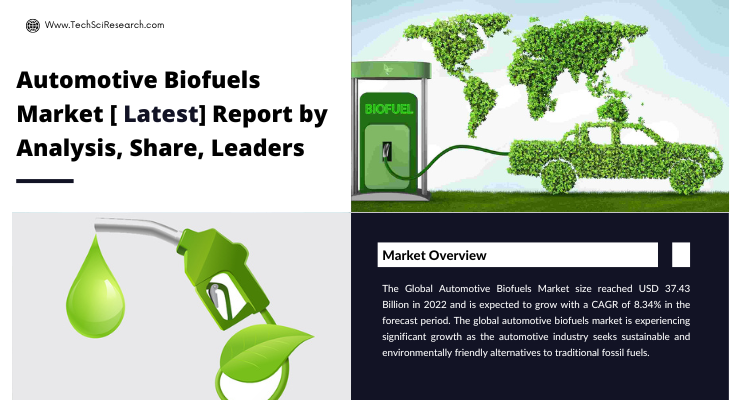According to TechSci Research report, “Automotive Biofuels Market – Global Industry Size, Share, Trends, Competition Forecast & Opportunities, 2028”, the Global Automotive Biofuels Market stood at USD 37.43 Billion in 2022 and is anticipated to grow with a CAGR of 8.34% in the forecast period, 2024-2028. The global automotive biofuels market is experiencing significant growth as the automotive industry seeks sustainable and environmentally friendly alternatives to traditional fossil fuels.
Biofuels, derived from renewable sources such as crops, agricultural residues, and waste materials, offer a viable solution to reduce greenhouse gas emissions and dependence on fossil fuels. One of the key drivers of the global automotive biofuels market is the increasing focus on reducing carbon emissions and meeting stringent environmental regulations. Biofuels, such as ethanol and biodiesel, have lower carbon emissions compared to conventional gasoline and diesel, making them an attractive option for reducing the carbon footprint of vehicles. Governments around the world are implementing policies and incentives to promote the use of biofuels, further driving market growth.
Another factor contributing to the growth of the automotive biofuels market is the rising demand for renewable energy sources. With the depletion of fossil fuel reserves and concerns about energy security, there is a growing need for sustainable alternatives. Biofuels provide a viable solution as they can be produced from a variety of feedstocks, reducing reliance on a single source of energy. Technological advancements in biofuel production processes are also driving market growth. Improved efficiency in biofuel production, such as the development of advanced conversion technologies and the use of genetically modified crops, has made biofuels more cost-effective and scalable. These advancements have also led to the production of advanced biofuels, such as cellulosic ethanol, which utilize non-food feedstocks and offer even lower carbon emissions.
However, the global automotive biofuels market also faces challenges. One of the key challenges is the availability and cost of feedstock for biofuel production. The competition for land and resources between food and fuel production can impact the market’s competitiveness. Additionally, concerns about the sustainability of biofuel production, such as land use change and its impact on biodiversity, need to be addressed to ensure the long-term viability of the market.
In conclusion, the global automotive biofuels market is driven by the need for sustainable and environmentally friendly alternatives to fossil fuels. With increasing environmental regulations, renewable energy goals, and technological advancements, biofuels are gaining traction as a viable solution for reducing carbon emissions and achieving energy security. However, addressing feedstock availability, sustainability concerns, and ensuring the scalability of biofuel production are crucial for the continued growth and success of the global automotive biofuels market.
Browse over XX market data Figures spread through XX Pages and an in-depth TOC on the ” Global Automotive Biofuels Market” @ https://www.techsciresearch.com/report/automotive-biofuels-market/22721.html
North America: North America is a significant market for automotive biofuels, driven by government regulations and initiatives promoting renewable fuels. The United States has implemented the Renewable Fuel Standard (RFS), which mandates the blending of biofuels into transportation fuels. This policy has stimulated the production and consumption of biofuels, particularly ethanol. The region also has a well-established infrastructure for biofuel distribution and consumption, with a network of blending facilities and biofuel filling stations.
Europe: Europe is another prominent region in the global automotive biofuels market, driven by the European Union’s Renewable Energy Directive (RED) and the implementation of blending mandates. The RED sets targets for the use of renewable energy in transportation, including biofuels. European countries have embraced biodiesel as a key biofuel, with a significant portion of diesel fuel being blended with biodiesel. The region also has a well-developed infrastructure for biofuel distribution, including blending mandates and dedicated biofuel filling stations.
Asia Pacific: Asia Pacific is a rapidly growing market for automotive biofuels, driven by factors such as increasing vehicle sales, government policies promoting renewable fuels, and concerns about air pollution. The region has diverse feedstock availability, with countries like China and Thailand focusing on sugarcane-based ethanol production, while countries like Indonesia and Malaysia utilize palm oil for biodiesel production. The region also has potential for the production of advanced biofuels, such as algae-based biofuels, given its favorable climate conditions. However, the market in Asia Pacific is still developing, and infrastructure for biofuel distribution and consumption is not as well-established as in other regions.
Latin America: Latin America is a significant player in the global automotive biofuels market, particularly in ethanol production. Countries like Brazil are leaders in sugarcane-based ethanol production and have a well-established biofuel industry. The region benefits from abundant land resources and favorable climate conditions for feedstock cultivation. The use of ethanol as a fuel additive or standalone fuel is widespread in the region, driven by government policies and the availability of flex-fuel vehicles that can run on different ethanol-gasoline blends.
In summary, regional insights into the global automotive biofuels market highlight the varying market dynamics and trends across different regions. Factors such as government policies, feedstock availability, infrastructure development, and consumer preferences shape the regional trends in the automotive biofuels market.
Major companies operating in the Global Automotive Biofuels Market are:
- Archer Daniels Midland Company
- Aceites Manuelita S.A.
- INEOS Group AG
- Neste Corporation
- Renewable Energy Group Inc.
- BlueFire Renewables
- Cosan
- Biowanze S.A.
- GLENCORE Magdeburg GmbH
- Cargill
Download Free Sample Report @ https://www.techsciresearch.com/sample-report.aspx?cid=22721
Customers can also request 10% free customization in this report
“The global automotive biofuels market is poised for significant growth in the coming years. The increasing focus on sustainability, government regulations promoting renewable fuels, and advancements in biofuel production technologies are driving the market’s expansion. Additionally, the growing demand for alternative energy sources and the need to reduce carbon emissions in the transportation sector further support the adoption of automotive biofuels,” said Mr. Karan Chechi, Research Director with TechSci Research, a research-based management consulting firm.
“Automotive Biofuels Market – Global Industry Size, Share, Trends Opportunity, and Forecast, Segmented By Feedstock Type (Corn Based, Sugarcane Based, Cellulosic Biomass and Others), By Biofuel Type (Ethanol, Biodiesel, Others), By Vehicle Type (Passenger Cars and Commercial Vehicles), By Region, Competition, 2018-2028”, has evaluated the future growth potential of Global Automotive Biofuels Market and provides statistics & information on market size, structure, and future market growth. The report intends to provide cutting-edge market intelligence and help decision makers take sound investment decisions. Besides, the report also identifies and analyzes the emerging trends along with essential drivers, challenges, and opportunities in the Global Automotive Biofuels Market.
You may also read:
Automotive Gear Oil Market Set for XX.XX% CAGR Through 2028- Forecasted Growth
Airbags and Seatbelts Market Detailed Analysis of Share, Growth [2028]
Automotive Coatings Market on the Rise [2028]- Driving Growth
Automotive Hypervisor Market Trends [2028]- Exploring the Dynamics of Industry
Automotive Bumper Market [2028] Analysis, Trends, and Key Players.
Table of Content-Automotive Biofuels Market
- Introduction
1.1. Product Overview
1.2. Key Highlights of the Report
1.3. Market Coverage
1.4. Market Segments Covered
1.5. Research Tenure Considered
- Research Methodology
2.1. Objective of the Study
2.2. Baseline Methodology
2.3. Key Industry Partners
2.4. Major Association and Secondary Sources
2.5. Forecasting Methodology
2.6. Data Triangulation & Validation
2.7. Assumptions and Limitations
- Executive Summary
3.1. Market Overview
3.2. Market Forecast
3.3. Key Regions
3.4. Key Segments
- Impact of COVID-19 on Global Automotive Biofuels Market
- Global Automotive Biofuels Market Outlook
5.1. Market Size & Forecast
5.1.1. By Value
5.2. Market Share & Forecast
5.2.1. By Feedstock Type Market Share Analysis (Corn Based, Sugarcane Based, Cellulosic Biomass and Others)
5.2.2. By Biofuel Type Market Share Analysis (Ethanol, Biodiesel, Others)
5.2.3. By Vehicle Type Market Share Analysis (Passenger Cars and Commercial Vehicles)
5.2.4. By Regional Market Share Analysis
5.2.4.1. Asia-Pacific Market Share Analysis
5.2.4.2. Europe & CIS Market Share Analysis
5.2.4.3. North America Market Share Analysis
5.2.4.4. South America Market Share Analysis
5.2.4.5. Middle East & Africa Market Share Analysis
5.2.5. By Company Market Share Analysis (Top 5 Companies, Others – By Value, 2022)
5.3. Global Automotive Biofuels Market Mapping & Opportunity Assessment
5.3.1. By Feedstock Type Market Mapping & Opportunity Assessment
5.3.2. By Biofuel Type Market Mapping & Opportunity Assessment
5.3.3. By Vehicle Type Market Mapping & Opportunity Assessment
5.3.4. By Regional Market Mapping & Opportunity Assessment
- Asia-Pacific Automotive Biofuels Market Outlook
6.1. Market Size & Forecast
6.1.1. By Value
6.2. Market Share & Forecast
6.2.1. By Feedstock Type Market Share Analysis
6.2.2. By Biofuel Type Market Share Analysis
6.2.3. By Vehicle Type Market Share Analysis
6.2.4. By Country Market Share Analysis
6.2.4.1. China Market Share Analysis
6.2.4.2. India Market Share Analysis
6.2.4.3. Japan Market Share Analysis
6.2.4.4. Indonesia Market Share Analysis
6.2.4.5. Thailand Market Share Analysis
6.2.4.6. South Korea Market Share Analysis
6.2.4.7. Australia Market Share Analysis
6.2.4.8. Rest of Asia-Pacific Market Share Analysis




